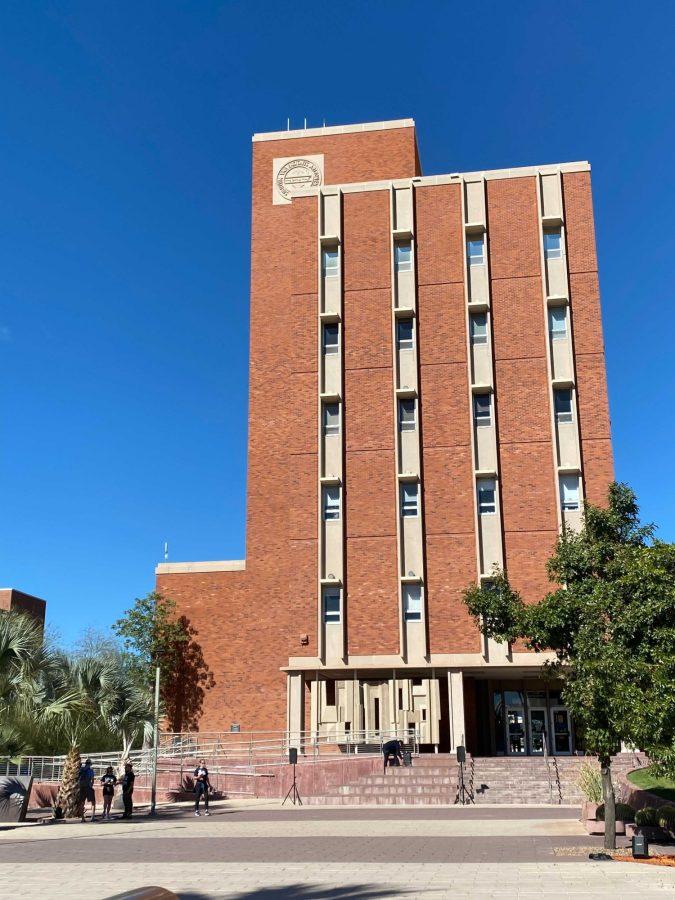Associated Students of the University of Arizona President Chris Nagata informed students and ASUA senators about the new proposed parameters of the student tuition proposal at yesterday’s meeting.
“”Tuition is quite possibly one of the most complicated and complex issues that the ASUA and student governments across the country deal with year in and year out,”” Nagata said. “”It’s no different for our organization.””
Nagata submitted the latest student tuition proposal late last week. It was met with support from President Robert Shelton and the Arizona Board of Regents.
The university currently has a $60 million deficit to account for, and every $45 increase to tuition yields $1 million, according to Nagata.
“”In order for the university to recoup the debt and the budget cuts, we need about a $2,700 increase to tuition,”” Nagata said.
Shelton’s original proposal, which was submitted in late February, laid out a plan to increase the tuition by more than $1,400 and acquire $2,900 over two years. That would mean an increase in tuition for the 2010-11 school year and the 2011-12 school year.
Shelton’s proposal also included a $766 surcharge, along with a $306 Campus Health Services and Student Recreation Center fee, a $335 technology fee and a $24 sustainability fee. If approved, students would be asked to pay around $2881 next year.
Instead, Nagata said a team of student representatives including students, the Graduate and Professional Student Council and ASUA met to come up with a more manageable amount. His proposal included a clause that ABOR voted on last year which mandated that returning students’ tuition not be increased by more than 5 percent.
Other provisions of the student proposal included a $382 increase in tuition for graduate students and a $324 increase for undergraduate students. Nagata acknowledged that this would not make up for the $60 million shortfall.
Therefore, the student proposal includes the $776 surcharge and an increased total of $90 for mandatory fees, which amounts to a total of $159 for Campus Health and the Rec Center, $120 for the library and information and $125 for technology.
Nagata told senators his proposal was well received by university officials, and Shelton submitted a new counter-proposal this morning.
“”In my four years, I have never seen ABOR be this invested or this supportive in a student tuition proposal,”” Nagata said.
The counter-proposal called for a $400 reduction from the initial cost increase along with an endorsement of the student recommended fees. Shelton’s latest proposal did not take into consideration the original mandate not to increase tuition by more than 5 percent for returning students.
“”It doesn’t necessarily make the tuition adjustments that much more palpable but it is a huge improvement from where we initially started,”” Nagata said. “”We will continue to work with all stakeholders in order to continue this (effort).””
ABOR meets tomorrow morning at 9:30 in the Grand Ballroom of the Student Union Memorial Center to review tuition proposals from the three major state universities and vote on the proposed increases.
Senators were also given a presentation on the new administrative computer system currently being used to replace Student Link. After spring break, students will no longer use Student Link to register for and otherwise manage their classes.
“”The current system takes a lot of manpower to manage, but we are changing to a simpler system,”” said Tom Bourgeois, student administration system co-director.
In addition to being easier to manage, the new system promises to be more efficient and offer more options for class management, according to Bourgeois.
Bourgeois said he and his team plan to continue transferring over the university’s student records during Spring Break in order to be ready for priority registration, which opens March 31.
During his presentation, Bourgeois encouraged all students to log onto the new system and make sure their records transferred correctly. He also said the new system was “”browser neutral”” for the most part but might not work with Google Chrome or Safari.
The new system will allow students to register for all at once, instead of one at a time. Students will continue using their Net IDs to log in.
During Bourgeois’ presentation, he demonstrated how students would be able to load multiple classes into a “”shopping cart”” and then click to enroll. OSCR lab monitors will be trained to assist students who have trouble with the new system.
The new system is similar to the administrative system used by Arizona State University and Northern Arizona University.
Bourgeois warned senators and students the new system would “”be a big shock,”” and take some adjustment.
“”We’ve done quite a bit so far and we still have quite a bit to do,”” Bourgeois said. “”It’s going to suck for a little while and then it will be good.””








